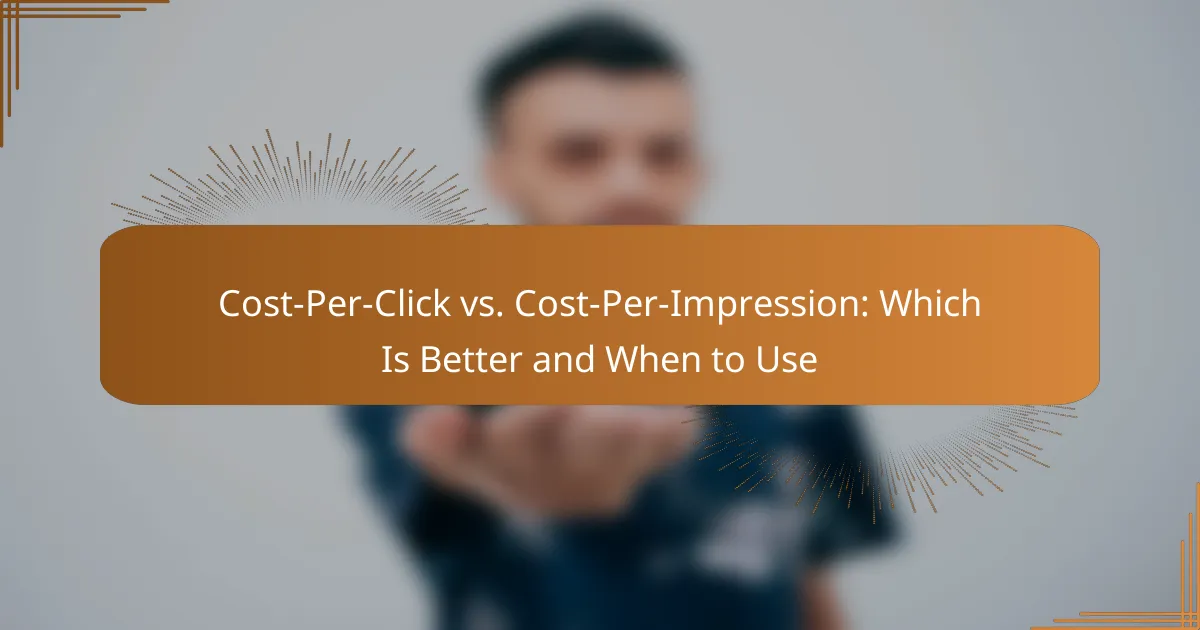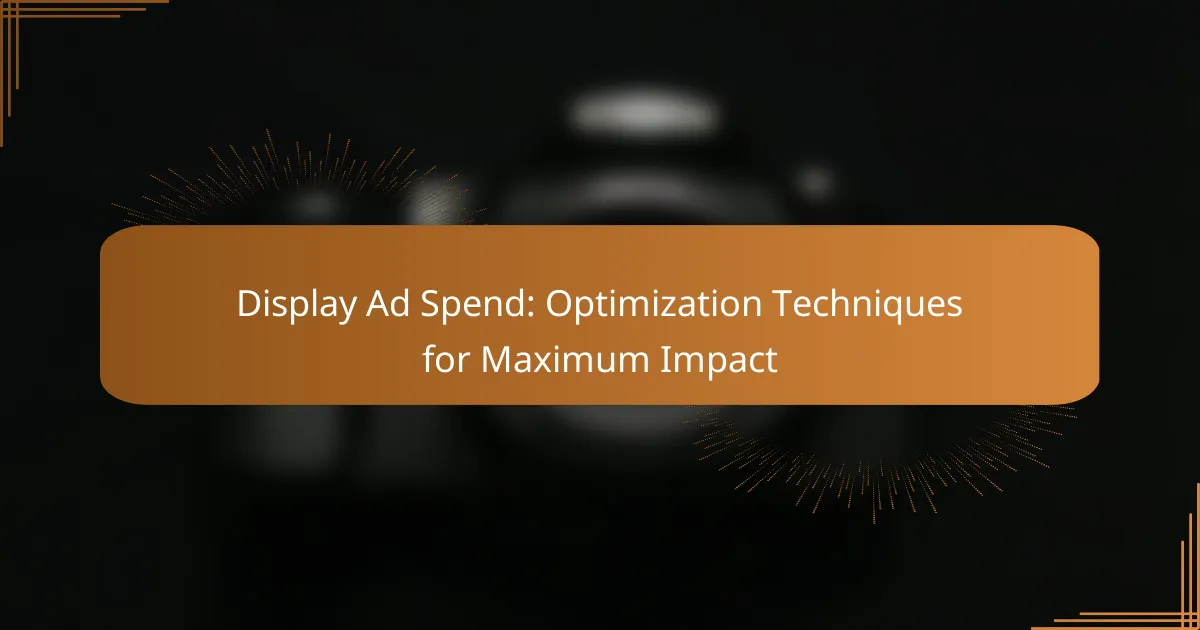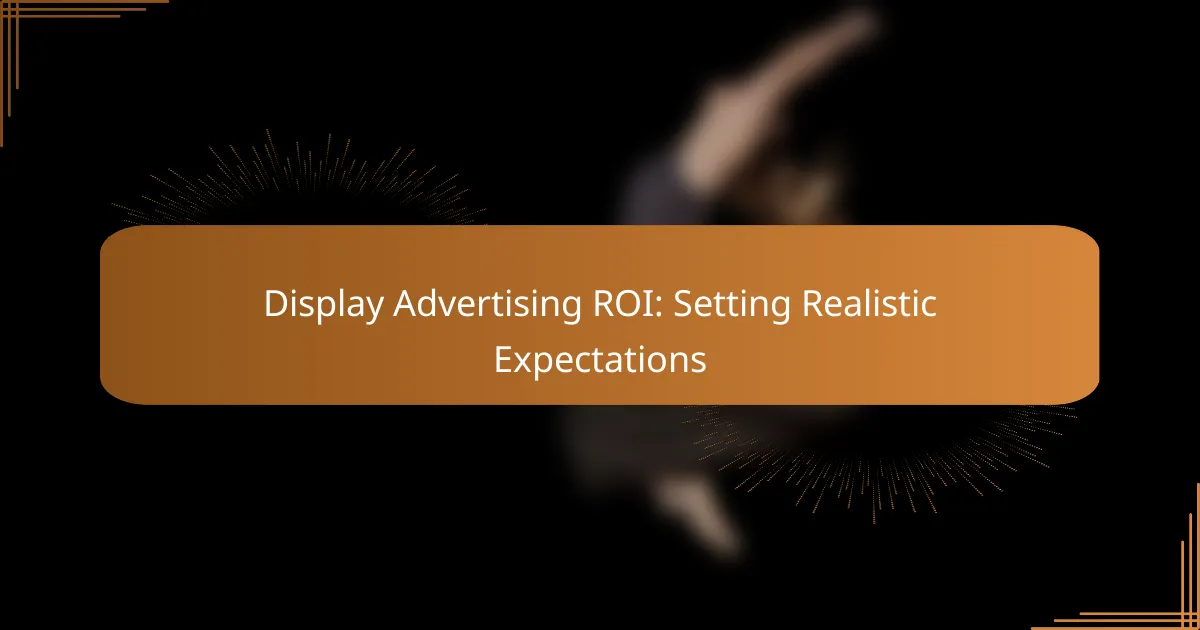Understanding the differences between Cost-Per-Click (CPC) and Cost-Per-Impression (CPM) is crucial for optimizing advertising strategies. CPC is ideal for campaigns aimed at driving traffic and generating leads, as advertisers only pay when users click on their ads. In contrast, CPM focuses on brand visibility, charging for every thousand impressions, making it suitable for campaigns that prioritize awareness over immediate engagement.

What is Cost-Per-Click (CPC) in display advertising?
Cost-Per-Click (CPC) in display advertising is a pricing model where advertisers pay a fee each time a user clicks on their ad. This model is designed to drive traffic to a website, making it a popular choice for campaigns focused on conversions and engagement.
CPC definition
CPC refers to the amount an advertiser pays for each click on their display ad. It is a key metric in online advertising, helping businesses gauge the effectiveness of their campaigns. Advertisers set a maximum CPC bid, which can vary based on competition and ad placement.
Benefits of CPC
CPC offers several advantages for advertisers. First, it ensures that costs are incurred only when users show interest by clicking on the ad, making it a cost-effective option for driving targeted traffic. Additionally, CPC campaigns can be easily optimized based on performance data, allowing for adjustments in real-time to maximize return on investment.
Another benefit is the ability to measure campaign effectiveness through metrics such as click-through rates (CTR) and conversion rates. This data helps advertisers refine their strategies and improve overall ad performance.
Common platforms using CPC
Several major advertising platforms utilize the CPC model, including Google Ads and Bing Ads. These platforms allow advertisers to bid on keywords and display their ads across a vast network of websites. Social media platforms like Facebook and Instagram also offer CPC options, enabling targeted advertising based on user demographics and interests.
When choosing a platform, consider the audience and type of content you want to promote. Each platform has its own bidding strategies and audience targeting capabilities, which can significantly impact the success of your CPC campaigns.

What is Cost-Per-Impression (CPM) in display advertising?
Cost-Per-Impression (CPM) in display advertising refers to the pricing model where advertisers pay for every thousand impressions their ads receive. This model focuses on brand visibility rather than direct clicks, making it suitable for campaigns aimed at increasing awareness.
CPM definition
CPM stands for Cost-Per-Mille, with “mille” meaning thousand in Latin. In this model, advertisers pay a set fee for every 1,000 times their ad is displayed, regardless of whether users interact with it. This approach allows advertisers to gauge the reach of their campaigns effectively.
Benefits of CPM
One of the primary benefits of CPM is its focus on brand exposure, making it ideal for campaigns aimed at building awareness rather than immediate conversions. Additionally, CPM can be more cost-effective for campaigns targeting large audiences, as it allows for budgeting based on impressions rather than clicks.
Another advantage is the simplicity of tracking impressions, which can provide clear metrics on how many times an ad has been seen. This can help advertisers assess the effectiveness of their campaigns in terms of visibility and reach.
Common platforms using CPM
Many popular advertising platforms utilize the CPM model, including Google Ads, Facebook Ads, and programmatic ad networks. These platforms allow advertisers to set up campaigns that focus on maximizing impressions across various websites and apps.
In addition to social media and search engines, display networks often offer CPM options, enabling advertisers to reach broader audiences across multiple sites. This flexibility makes CPM a common choice for brand-oriented campaigns in digital advertising.

When should you use Cost-Per-Click?
Cost-Per-Click (CPC) is best used when the goal is to drive traffic to a website or generate leads. This model charges advertisers only when a user clicks on their ad, making it ideal for campaigns focused on immediate engagement and conversion.
Best scenarios for CPC
CPC is particularly effective for businesses looking to boost website visits or sales directly. For example, e-commerce sites often benefit from CPC campaigns, as they can track sales directly linked to ad clicks. Additionally, time-sensitive promotions or product launches are great scenarios for CPC, as they encourage quick user action.
Another scenario is when you have a clear understanding of your customer acquisition cost. If you know how much you can afford to spend per click while still maintaining profitability, CPC can be a powerful tool for maximizing your return on investment.
Target audience considerations for CPC
Understanding your target audience is crucial for a successful CPC campaign. If your audience is highly engaged and likely to click on ads, CPC can yield better results. For instance, tech-savvy consumers may respond well to targeted ads for new gadgets, while less engaged audiences might require different strategies.
Consider the demographics and online behavior of your audience. If your target market frequently uses search engines to find products or services, CPC can effectively capture their attention. Conversely, if your audience is less likely to click on ads, exploring other models like Cost-Per-Impression (CPI) might be more beneficial.

When should you use Cost-Per-Impression?
Cost-Per-Impression (CPM) is best used when brand visibility is the primary goal rather than direct conversions. This model is effective for campaigns focused on reaching a large audience, as it charges advertisers based on the number of times their ad is displayed, regardless of clicks.
Best scenarios for CPM
CPM is ideal for campaigns aimed at building brand awareness or promoting new products. For instance, if a company is launching a new beverage, using CPM can help ensure that the ad reaches a wide audience quickly, maximizing exposure.
Additionally, CPM works well for display advertising on platforms like social media or news websites where the goal is to get as many impressions as possible. This approach is particularly beneficial for businesses in competitive markets where visibility can lead to increased brand recognition.
Target audience considerations for CPM
When using CPM, understanding your target audience is crucial. Advertisers should consider demographics, interests, and online behavior to ensure that the ad impressions are reaching the right people. For example, a fashion brand targeting young adults may choose platforms frequented by that demographic to maximize the impact of their impressions.
Moreover, analyzing past campaign performance can provide insights into which audience segments respond best to impressions. This data can help refine targeting strategies and improve overall campaign effectiveness, ensuring that ad spend is optimized for the desired audience.
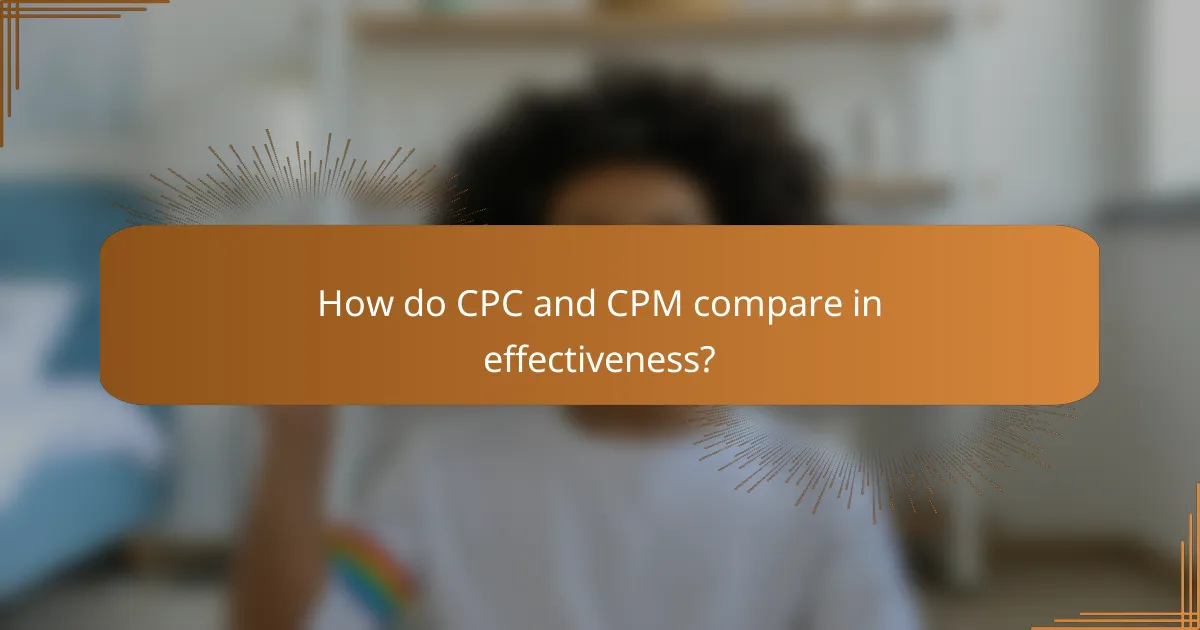
How do CPC and CPM compare in effectiveness?
CPC (Cost-Per-Click) and CPM (Cost-Per-Thousand Impressions) serve different advertising objectives, making their effectiveness context-dependent. CPC is often more effective for campaigns focused on driving traffic, while CPM can be better for brand awareness and visibility.
Cost-effectiveness analysis
When evaluating cost-effectiveness, consider your campaign goals. CPC is typically more cost-effective for direct response campaigns where clicks lead to conversions. In contrast, CPM can be advantageous for campaigns aimed at reaching a broader audience, as it allows for a fixed cost for a set number of impressions.
For example, if your goal is to generate leads, investing in CPC might yield a higher return on investment (ROI) since you pay only when users engage. However, if your aim is to increase brand recognition, CPM may be more suitable as it maximizes exposure at a lower cost per impression.
Performance metrics comparison
Performance metrics for CPC and CPM differ significantly. With CPC, key metrics include click-through rate (CTR) and conversion rate, which help assess the effectiveness of driving traffic to your site. A higher CTR indicates that your ads resonate with the audience, while a strong conversion rate shows that clicks are translating into desired actions.
On the other hand, CPM focuses on metrics like reach and frequency. Reach measures how many unique users see your ad, while frequency indicates how often they see it. These metrics are crucial for understanding brand visibility and ensuring that your message is being seen by the target audience without overwhelming them.
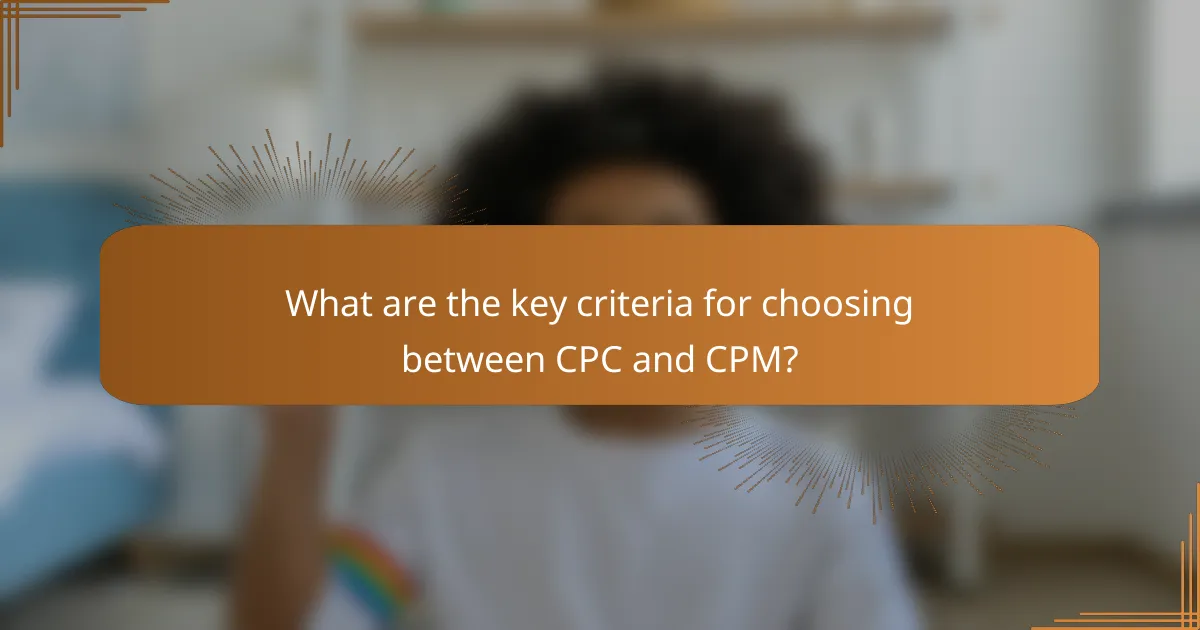
What are the key criteria for choosing between CPC and CPM?
Choosing between Cost-Per-Click (CPC) and Cost-Per-Impression (CPM) depends on your advertising objectives and budget. CPC is ideal for campaigns focused on driving traffic, while CPM is better for brand awareness and visibility.
Budget considerations
When evaluating CPC versus CPM, consider your overall advertising budget and how you allocate funds. CPC campaigns typically require a more direct investment per click, which can lead to higher costs if your click-through rate (CTR) is low. In contrast, CPM allows for broader reach at a fixed cost per thousand impressions, making it potentially more cost-effective for brand exposure.
For example, if your budget is limited, you might prefer CPM to maximize visibility. However, if you have a higher budget and aim for specific actions, CPC could yield better returns. Always monitor your spending to avoid exceeding your limits.
Campaign goals alignment
Your campaign goals should dictate whether you choose CPC or CPM. If your primary objective is to drive traffic to your website or generate leads, CPC is more appropriate as you pay only for actual clicks. This model aligns well with performance-based marketing strategies.
On the other hand, if your goal is to enhance brand awareness or reach a larger audience, CPM is the better choice. This model allows you to display your ads to a vast number of users, even if they do not click. Assess your goals carefully to ensure your chosen model aligns with your desired outcomes.

What are the emerging trends in CPC and CPM?
Emerging trends in Cost-Per-Click (CPC) and Cost-Per-Impression (CPM) reflect shifts in digital advertising strategies, particularly as advertisers seek more effective ways to allocate their budgets. Increasingly, data-driven approaches and advanced targeting techniques are influencing how these models are utilized across various platforms.
Increased Use of Automation
Automation is becoming a key trend in both CPC and CPM advertising, allowing marketers to optimize their campaigns in real-time. Tools powered by artificial intelligence can analyze vast amounts of data to adjust bids and placements, ensuring that advertisers achieve better ROI.
For instance, platforms like Google Ads and Facebook Ads are incorporating machine learning algorithms that help in predicting performance and adjusting strategies accordingly. This shift towards automation can lead to more efficient spending and improved ad performance.
Focus on Audience Targeting
Audience targeting is increasingly important in determining the effectiveness of CPC and CPM campaigns. Advertisers are leveraging detailed demographic, behavioral, and psychographic data to reach specific segments of the market, which enhances engagement and conversion rates.
For example, using tools like lookalike audiences on social media can help brands find new customers similar to their existing ones, making CPC campaigns more effective. In contrast, CPM campaigns benefit from precise targeting by ensuring that impressions are served to the most relevant audiences.
Shift Towards Mobile and Video Advertising
Mobile and video advertising are gaining traction, significantly affecting CPC and CPM strategies. With the rise of mobile device usage, advertisers are focusing on mobile-optimized ads to capture the attention of users on the go.
Video content, in particular, is proving to be a powerful medium, often commanding higher CPM rates due to its engaging nature. Advertisers are encouraged to create compelling video ads that resonate with their target audience, as this can lead to higher click-through rates and better overall performance.
